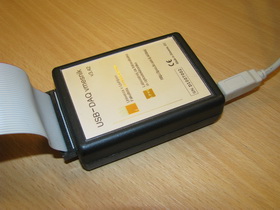^
Data acquisition

Data acquisition (DAQ) is a process of sampling signals that measure real world physical conditions and converting the resulting samples into digital numeric values that can be manipulated by a host. The components of a typical DAQ system include: signal conditioning circuitry to convert sensor signals into a form that can be converted to digital values, analog-to-digital converters, which convert conditioned sensor signals to digital values and a bus used to connect to a host system that in most cases is a personal computer.
^
Hardware description
An USB DAQ interface has been developed with 8-channel 16-bit differential analog input stage capable of sample rates up to 250 000 samples per second. The interface also includes a four channel D/A converter with 12 bit resolution suitable for generating DC bias voltages and slow AC signals. The interconnecting bus is USB 2.0 full-speed compliant. Input and output voltage range is 5 V or 10 V but can be further customized upon request.
Technical specifications (for 10 V version)
|
parameter
|
min
|
typ
|
max
|
|
A/D converter
|
|
|
|
|
differential input voltage range
|
|
±10 V
|
|
|
absolute input voltage range
|
|
10 V
|
|
|
absolute maximum input voltage
|
|
|
12 V
|
|
|
|
|
|
|
sampling rate
|
1 Hz
|
|
250 kHz
|
|
|
|
|
|
|
input noise
|
|
±2 LSB
|
|
|
CMRR @ 1 kHz
|
|
60 dB
|
|
|
CMRR @ 80 kHz
|
|
46 dB
|
|
|
|
|
|
|
|
D/A converter
|
|
|
|
|
output voltage range
|
0 V
|
|
10 V
|
|
output accuracy
|
|
±3% FSO
|
|
|
output noise
|
|
±4 mVpp
|
|
^
Software
Software support includes the following Microsoft operating systems: Windows XP, Windows Vista and Windows 7. The DAQ interface can be used in any Windows development environment, Matlab or any other software capable of importing and using functions from a dll library. Furthermore a complete driver interface is available for the NI LabView software package.



